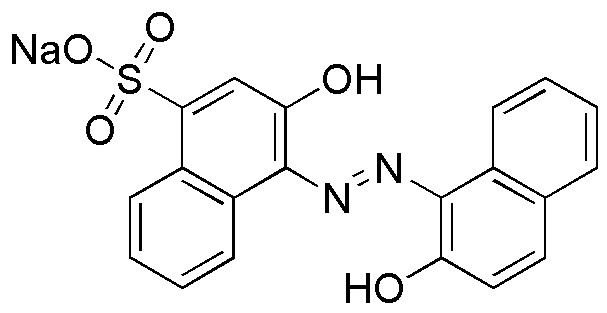Eriochrome Blue Black R is widely utilized in research focused on:
- Colorimetric Analysis: This compound serves as a dye in colorimetric assays, allowing researchers to detect and quantify metal ions in solution, particularly in environmental and analytical chemistry.
- Water Quality Testing: It is commonly used in water testing kits to determine the presence of heavy metals, providing a simple and effective method for monitoring water safety.
- Textile Industry: The dye is applied in the textile sector for coloring fabrics, offering vibrant hues and excellent fastness properties, making it a preferred choice for high-quality textiles.
- Biological Staining: In microbiology, it is used as a staining agent for visualizing cellular structures under a microscope, enhancing the clarity of biological samples.
- Research in Analytical Chemistry: Eriochrome Blue Black R is utilized in developing new analytical methods, particularly in studies involving complexometric titrations, due to its ability to form stable complexes with various metal ions.
General Information
Properties
Safety and Regulations
Applications
Eriochrome Blue Black R is widely utilized in research focused on:
- Colorimetric Analysis: This compound serves as a dye in colorimetric assays, allowing researchers to detect and quantify metal ions in solution, particularly in environmental and analytical chemistry.
- Water Quality Testing: It is commonly used in water testing kits to determine the presence of heavy metals, providing a simple and effective method for monitoring water safety.
- Textile Industry: The dye is applied in the textile sector for coloring fabrics, offering vibrant hues and excellent fastness properties, making it a preferred choice for high-quality textiles.
- Biological Staining: In microbiology, it is used as a staining agent for visualizing cellular structures under a microscope, enhancing the clarity of biological samples.
- Research in Analytical Chemistry: Eriochrome Blue Black R is utilized in developing new analytical methods, particularly in studies involving complexometric titrations, due to its ability to form stable complexes with various metal ions.
Documents
Safety Data Sheets (SDS)
The SDS provides comprehensive safety information on handling, storage, and disposal of the product.
Product Specification (PS)
The PS provides a comprehensive breakdown of the product’s properties, including chemical composition, physical state, purity, and storage requirements. It also details acceptable quality ranges and the product's intended applications.
Certificates of Analysis (COA)
Search for Certificates of Analysis (COA) by entering the products Lot Number. Lot and Batch Numbers can be found on a product’s label following the words ‘Lot’ or ‘Batch’.
*Catalog Number
*Lot Number
Certificates Of Origin (COO)
This COO confirms the country where the product was manufactured, and also details the materials and components used in it and whether it is derived from natural, synthetic, or other specific sources. This certificate may be required for customs, trade, and regulatory compliance.
*Catalog Number
*Lot Number
Safety Data Sheets (SDS)
The SDS provides comprehensive safety information on handling, storage, and disposal of the product.
DownloadProduct Specification (PS)
The PS provides a comprehensive breakdown of the product’s properties, including chemical composition, physical state, purity, and storage requirements. It also details acceptable quality ranges and the product's intended applications.
DownloadCertificates of Analysis (COA)
Search for Certificates of Analysis (COA) by entering the products Lot Number. Lot and Batch Numbers can be found on a product’s label following the words ‘Lot’ or ‘Batch’.
*Catalog Number
*Lot Number
Certificates Of Origin (COO)
This COO confirms the country where the product was manufactured, and also details the materials and components used in it and whether it is derived from natural, synthetic, or other specific sources. This certificate may be required for customs, trade, and regulatory compliance.


